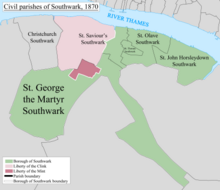
The London Borough of Southwark in South London forms part of Inner London and is connected by bridges across the River Thames to the City of London and London Borough of Tower Hamlets. It was created in 1965 when three smaller council areas amalgamated under the London Government Act 1963. All districts of the area are within the London postal district. It is governed by Southwark London Borough Council.

Kennington is a district in south London, England. It is mainly within the London Borough of Lambeth, running along the boundary with the London Borough of Southwark, a boundary which can be discerned from the early medieval period between the Lambeth and St George's parishes of those boroughs respectively. It is located 1.4 miles (2.3 km) south of Charing Cross in Inner London and is identified as a local centre in the London Plan. It was a royal manor in the parish of St Mary, Lambeth in the county of Surrey and was the administrative centre of the parish from 1853. Proximity to central London was key to the development of the area as a residential suburb and it was incorporated into the metropolitan area of London in 1855.

Lambeth is a London borough in South London, England, which forms part of Inner London. Its name was recorded in 1062 as Lambehitha and in 1255 as Lambeth. The geographical centre of London is at Frazier Street near Lambeth North tube station, though nearby Charing Cross on the other side of the Thames in the City of Westminster is traditionally considered the centre of London.

GKT School of Medical Education is the medical school of King's College London. The school has campuses at three institutions, Guy's Hospital (Southwark), King's College Hospital and St Thomas' Hospital (Lambeth) in London – with the initial of each hospital making up the acronymous name of the school. The school in its current guise was formed following a merger with the United Medical and Dental Schools of Guy's and St Thomas' Hospitals on 1 August 1998. As of 2023, the medical school is ranked 5th best in the UK for clinical medicine by U.S. News & World Report, and 10th best worldwide by Times Higher Education.

King's College London is a public research university located in London, England. King's was established by royal charter in 1829 under the patronage of King George IV and the Duke of Wellington. In 1836, King's became one of the two founding colleges of the University of London. It is one of the oldest university-level institutions in England. In the late 20th century, King's grew through a series of mergers, including with Queen Elizabeth College and Chelsea College of Science and Technology, the Institute of Psychiatry, the United Medical and Dental Schools of Guy's and St Thomas' Hospitals and the Florence Nightingale School of Nursing and Midwifery.

The Old Operating Theatre Museum and Herb Garret at 9a St Thomas Street is a museum of surgical history and one of the oldest surviving operating theatres. It is located in the garret of St Thomas's Church, Southwark, in London, on the original site of St Thomas' Hospital.

King's College Hospital is a major teaching hospital and major trauma centre in Denmark Hill, Camberwell in the London Borough of Lambeth, referred to locally and by staff simply as "King's" or abbreviated internally to "KCH". It is managed by King's College Hospital NHS Foundation Trust. It serves an inner city population of 700,000 in the London boroughs of Southwark and Lambeth, but also serves as a tertiary referral centre in certain specialties to millions of people in southern England. It is a large teaching hospital and is, with Guy's Hospital and St. Thomas' Hospital, the location of King's College London School of Medicine and one of the institutions that comprise the King's Health Partners, an academic health science centre. The chief executive is Dr Clive Kay. It is also the birthplace of Queen Camilla.
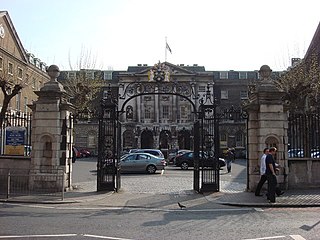
Guy's Hospital is an NHS hospital founded by Thomas Guy, located in the borough of Southwark in central London. It is part of Guy's and St Thomas' NHS Foundation Trust and one of the institutions that comprise the King's Health Partners, an academic health science centre.

Evelina London Children's Hospital is a specialist NHS hospital in London. It is administratively a part of Guy's and St Thomas' NHS Foundation Trust and provides teaching hospital facilities for London South Bank University and King's College London School of Medicine. Formerly housed at Guy's Hospital in Southwark, it moved to a new building alongside St Thomas' Hospital in Lambeth on 31 October 2005.
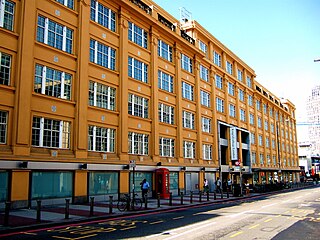
The Florence Nightingale Faculty of Nursing, Midwifery & Palliative Care is an academic faculty within King's College London. The faculty is the world's first nursing school to be continuously connected to a fully serving hospital and medical school. Established on 9 July 1860 by Florence Nightingale, the founder of modern nursing, it was a model for many similar training schools through the UK, Commonwealth and other countries for the latter half of the 19th century. It is primarily concerned with the education of people to become nurses and midwives. It also carries out nursing research, continuing professional development and postgraduate programmes. The Faculty forms part of the Waterloo campus on the South Bank of the River Thames and is now one of the largest faculties in the university.

Westminster Bridge Road is a road in London, England. It runs on an east–west axis and passes through the boroughs of Lambeth and Southwark.
The Seafarers Hospital Society, formerly the Seamen's Hospital Society, is a charity for people currently or previously employed by the British Merchant Navy and fishing fleets, and their families. It was established in 1821.

South London and Maudsley NHS Foundation Trust, also known as SLaM, is an NHS foundation trust based in London, England, which specialises in mental health. It comprises four psychiatric hospitals, the Ladywell Unit based at University Hospital Lewisham, and over 100 community sites and 300 clinical teams. SLaM forms part of the institutions that make up King's Health Partners, an academic health science centre.
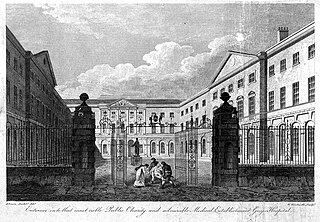
Guy's Campus is a campus of King's College London adjacent to Guy's Hospital and situated close to London Bridge and the Shard, on the South Bank of the River Thames in London. It is home to the Faculty of Life Sciences & Medicine and the Dental Institute.
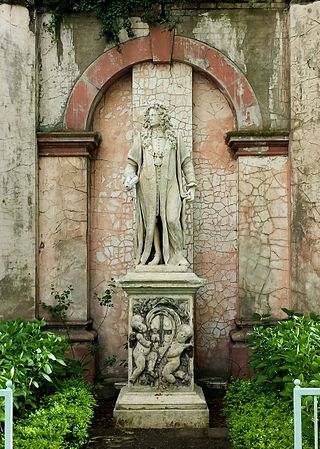
The statue of Robert Clayton stands at the entrance to the North Wing of St Thomas' Hospital, Lambeth, London. The sculptor was Grinling Gibbons, and the statue was executed around 1700–1714. Sir Robert was a banker, politician and Lord Mayor of London. As President of St Thomas', he was responsible for the complete rebuilding of the hospital, and associated church in the late 17th century. The statue was designated a Grade I listed structure in 1979.

Dulwich Community Hospital was a hospital located in Dulwich, in South London.
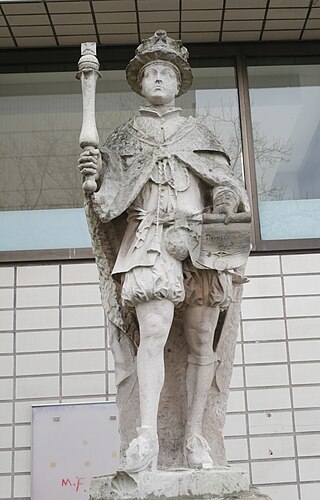
The statue of Edward VI by Thomas Cartwright at St Thomas' Hospital, Lambeth, London is one of two statues of that king at the hospital. Both commemorate Edward's re-founding of the institution in 1551. The statue was designed by Nathaniel Hanwell and carved by Thomas Cartwright in 1682, during the rebuilding undertaken by Sir Robert Clayton when President of the hospital. The statue originally formed the centrepiece of a group of figures which adorned the gateway on Borough High Street. It was moved to its current location at the north entrance to the North Wing on Lambeth Palace Road in the 20th century. It was designated a Grade II* listed structure in 1979.

The statue of Edward VI by Peter Scheemakers at St Thomas' Hospital, Lambeth, London is one of two statues of the king at the hospital. Both commemorate Edward's re-founding of the hospital in 1551. It was moved to its current location inside the North Wing of the hospital in the 20th century. The sculpture was designated a Grade II* listed structure in 1979.

The statue of Mary Seacole stands in the grounds of St Thomas' Hospital, Lambeth, London. Sculpted by Martin Jennings, the statue was executed in 2016. It honours Mary Seacole, a British-Jamaican who established a "British Hotel" during the Crimean War and who was posthumously voted first in a poll of "100 Great Black Britons".





